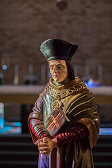
St Thomas More (1478-1535) was the son of Sir John More, a barrister and judge in the City of London who married four times. It is thought Thomas’ mother was Agnes Graunger, his father’s first wife. Thomas followed his father by practicing Law but did initially consider a vocation to the priesthood. In 1504 he entered Parliament. He married Jane Colt in 1505 and three daughters and a son were born of the marriage. But Jane died in 1511 and Thomas More married Alice Middleton, a widow, a few weeks after his first wife’s death.
Henry VIII, who became king in 1509, recognised Thomas More’s integrity and his many gifts. He promoted him to a whole series of public offices. More became Lord Chancellor of England in 1529, succeeding Cardinal Wolseley who fell out of favour with the king for failing to secure papal approval for Henry to divorce his first wife, Catherine of Aragon.
Thomas More was greatly influenced by the intellectual movements of the time. The Dutch humanist, Erasmus of Rotterdam, became his great friend. More gained a reputation as a man of letters, introducing the spirit and learning of the Renaissance into England. His most notable publication was Utopia (1516).
His cultured and happy family life included the education of his daughters, especially Margaret Roper, to a level surpassing what was available to most women of the time. More lived on a grand scale appropriate to his rank and social position, but regularly involved himself and his family in prayers and mortification. He was a man of deep spirituality. Henry VIII often called at More’s Chelsea home on the River Thames, arriving by barge. But Henry’s marriage plans, resulting from his lack of a male heir, began to cause problems with the friendship.
When the clergy declared the King to be the Supreme Head of the Church of England in 1532, More resigned the Chancellorship. In 1534 he was required to swear that he recognised, as heir to the throne, the infant daughter born from Henry’s second marriage to Anne Boleyn. He was ready to do this, since Parliament had so decided, but he declined to take the oath in the form in which it was worded as it obliged him to reject the
spiritual authority of the pope within the Church in England. Because of this he was imprisoned in the Tower of London. A body of legislation was then passed by Parliament under which it became high treason, punishable by death, to refuse to acknowledge the King as Head of the Church. More remained silent when asked to make this acknowledgement. He was brought to trial and despite a skillful defense, was found guilty.
Thomas More was beheaded on Tower Hill on 6 July 1535. He went to his death with the words of being “the King’s good servant, but God’s first.”
Thomas More was canonised in 1935. His feast day is observed on 22 June, a feast he shares with his friend John Fisher, bishop of Rochester, who was beheaded on Tower Hill on that day in 1535, just two week’s before More’s execution. Robert Bolt’s play about St Thomas More enables us to remember him as “A Man for All Seasons”.
![]()
